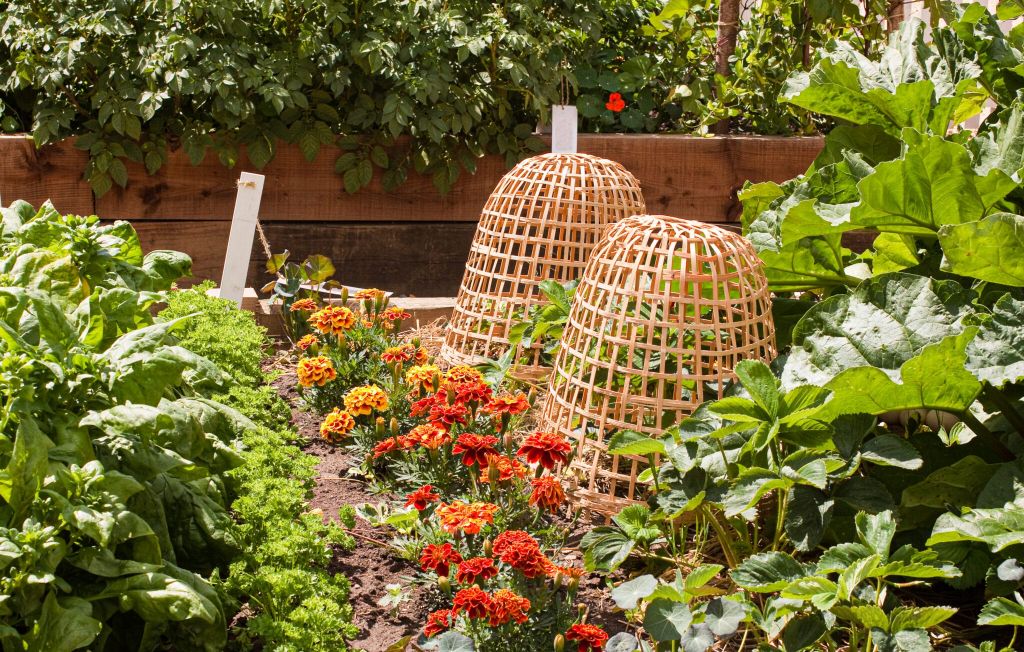Organic Pest Control In Edible Gardens: Natural Solutions For Common Pests
Organic pest control refers to utilizing natural approaches rather than chemical pesticides to manage insect, weed, and disease problems in edible home gardens. With growing consumer interest in reducing synthetic pesticide use due to concerns about health and the environment, the home and garden pesticides market is shifting towards more organic solutions. According to https://www.thebrainyinsights.com/report/home-and-garden-pesticides-market-13712 the home and garden pesticides market was valued at $9.63 billion in 2022 and is expected to grow at a CAGR of 7.22% through 2032 as demand increases for organic pest control alternatives. While completely avoiding pest issues in edible gardens is nearly impossible, there are many effective organic methods gardeners can employ to deal with common insect pests like aphids, squash bugs, cabbage worms and slugs as well as small animal pests like moles, rabbits, and deer. This includes solutions like repellent plants, traps, barriers, beneficial insects, and natural pesticide sprays made from plants or minerals.
Benefits of Organic Pest Control
Organic pest control offers several advantages over chemical pesticides. Some key benefits include:
Safer for people, pets, wildlife
Organic pest control methods are generally less toxic and pose fewer health risks for people, pets, and other non-target species. Synthetic chemical pesticides can linger in the environment and on food crops, putting families and wildlife at risk for negative health effects (Source: https://www.doitbest.com/global/ideas/lawn-garden/4-benefits-of-organic-pest/). Organic approaches provide pest control without exposing living things to hazardous substances.
Prevent pest resistance
Repeated use of chemical pesticides can lead insects and other pests to develop resistance. Organic techniques like natural predators, pheromone traps, and plant-based repellents work in different ways that are less likely to create resistant pest populations. This helps maintain long-term effectiveness (Source: https://aaaorganicpestcontrolnm.com/residential/organic/).
Improve soil health
Organic pest control supports overall soil quality, as it avoids adding toxic residues that can persist and accumulate. Healthier soil enables plants to be more resistant to pests naturally and provides habitat for beneficial organisms (Source: https://paidepo.com/blogs/news/what-are-the-benefits-of-organic-pest-control).
Maintain ecological balance
Organic methods work with nature rather than disrupting it. They help support biodiversity and stability in the garden ecosystem instead of killing indiscriminately. This balanced approach fosters thriving soil, plants, and wildlife populations that keep each other in check (Source: https://paidepo.com/blogs/news/what-are-the-benefits-of-organic-pest-control).
Common Insect Pests
Some of the most common insect pests that plague edible gardens in the Midwest include:
Aphids
Aphids are soft-bodied insects that come in a variety of colors like green, black, brown, yellow, or white. They tend to cluster on the undersides of leaves and stems where they suck the juices out of plants. Aphid populations can explode rapidly, and they excrete a sticky substance called honeydew that can attract other pests like ants. Aphids stunt plant growth and can spread viral diseases between plants. They are common pests on vegetables like lettuce, broccoli, cabbage and squash.
To control aphids organically, knock them off plants with a strong stream of water, spray insecticidal soap or neem oil on plants, or attract natural predators like ladybugs. Row covers and reflective mulches can also help prevent aphids early in the season. (Source)
Japanese Beetles
Japanese beetles are metallic green and copper beetles around 1/2 inch long. They skeletonize leaves, leaving only the veins behind. Adults emerge in mid-summer to feed on over 300 species of ornamental plants and trees as well as fruits and vegetables. They are especially problematic for plants like beans, raspberries, apple trees, roses, and grape vines.
Handpicking beetles, using traps, applying neem oil, and encouraging natural predators can help control Japanese beetles without insecticides. Floating row covers can exclude the beetles before damage occurs.
Cabbage Worms
Cabbage worms are the larvae of cabbage white butterflies. They chew large, irregular holes in the leaves of plants in the cabbage family. They can be green, brown, or yellow and are hard to see until plants are heavily damaged because they blend in with leaves.
Wrap the base of cabbage-family plants with aluminum foil or collars to prevent cabbage worms from reaching developing leaves. Use biological insecticides with Bt or spinosad to kill larvae. Encourage natural predators like birds and parasitic wasps.
Squash Bugs
Squash bugs are brown or gray flattened insects about 5/8 inch long. They suck juices from squash and pumpkin plants, especially vine stems and undersides of leaves. This causes wilting, plant decline, and poor fruit production.
Handpicking egg clusters in the spring can help reduce squash bug populations. Use row covers early in the season. Trap squash bugs under boards near plants to kill them. Insecticides like neem, pyrethrin or spinosad can control heavy infestations.
Tomato Hornworms
Tomato hornworms are large green caterpillars with white v-shaped markings and a horn on their rear. They chew irregular holes in leaves and can completely defoliate tomato plants. Hornworms also attack eggplant, pepper and potato plants.
Handpick caterpillars from infested plants and destroy them to prevent further damage. Use Bacillus thuringiensis (Bt) or spinosad spray for heavy infestations. Row covers can exclude the adult hornworm moths.
Common Animal Pests
Deer can be a very destructive force in vegetable gardens. They will munch on almost any vegetable, and can decimate a garden overnight (Fafard). Deer-resistant plants, fences at least 8 feet tall, and deterrents like scent repellents can help protect crops.
Rabbits are another problematic critter for edible gardens. They can burrow under fences and seem to have a taste for most vegetables. Choose plants rabbits tend to avoid, surround plants with chicken wire, or try repellents to keep them at bay (Critter-Repellent).
Moles can be hugely disruptive as they tunnel just below the soil surface. Their tunnels can dislodge plant roots, leading to death of the plant. Deterring moles with vibration devices, traps, or mole repellents can help save garden plants (Urban Leaf).
Voles are small rodents that live underground and feed on roots and tubers. They can destroy root crops and eat seeds. Protect plants with hardware cloth buried at least 3 inches deep, and try repellents to drive voles away (Urban Leaf).
Tree squirrels and ground squirrels can decimate fruit and nut crops with their feeding. Surround trees with 2 foot tall wire mesh, use deterrents like hot pepper spray, and trap nuisance squirrels to protect produce (Urban Leaf).
Repellent Plants
Certain plants can be strategically planted in an edible garden to repel common insect and animal pests. Some of the most effective repellent plants include:
Mint – Mint plants contain menthol, a natural insect repellent. The strong scent of mint repels many insects including ants, aphids, cabbage moths, flea beetles, squash bugs, and weevils. Interplanting mint near vegetables and fruits can help deter these insect pests.
Garlic – Garlic’s strong odor repels insects like aphids, cabbage loopers, fruit flies, fungus gnats, Japanese beetles, mosquitoes, snails, and spider mites. Garlic also helps repel deer, rabbits, and other animal pests. Planting garlic around the outer edges of an edible garden can act as a protective barrier.
Chives – Like other alliums, chives contain compounds that are naturally repellent to insects. Aphids, Japanese beetles, caterpillars, carrot flies, and cabbage worms avoid the scent of chives. Plant chives throughout the garden to deter these pests.
Marigolds – Marigolds contain thiophene compounds in their roots that repel nematodes, tiny roundworms that attack plant roots. Interplanting marigolds around vegetables helps protect their root systems from nematodes.

Physical Barriers
Physical barriers can be very effective for protecting plants from insect pests in an edible garden. Some common types of physical barriers include:
Floating Row Covers
Floating row covers are lightweight fabrics that drape directly over plants to create a protective barrier. They allow air, light, and water through while keeping out many flying and crawling pests. Floating row covers can help shield seedlings and vegetables from damage. Remove them once flowering begins so pollinators can access the plants (Source).
Garden Netting
Different types of garden netting can be draped over plants or used to enclose growing areas. Insect netting has very fine mesh for excluding tiny insects like thrips and aphids. Bird netting has wider openings to keep out larger pests. Netting acts as a physical pest barrier while still letting in sunlight, air flow, and irrigation (Source).
Tree Guards
Wrapping hardware cloth, aluminum flashing, or plastic guards around the trunks of trees can prevent climbing pests like coddling moths, borers, and caterpillars from accessing the bark and branches. Remove tree guards during the winter to prevent damage from moisture and rodents (Source).
Raised Beds
Elevating garden beds can make it harder for slugs, snails, and other ground-dwelling pests to access plants. The vertical sides of raised beds act as a barrier that pests must climb over. Raised beds also improve drainage and aeration.
Traps
Traps can be an effective organic method for controlling pests in an edible garden. Some common types of traps include:
Sticky traps: These traps use a sticky adhesive to catch insects and prevent them from reaching plants. Yellow or blue sticky traps attract flying insects like fungus gnats, whiteflies, leafminers, thrips, and aphids. They can be placed near affected plants, mounted on stakes above the plant canopy, or laid on the soil to trap insects at soil level.
Pheromone traps: Traps that use pheromones (scents insects produce) can attract and trap pests like codling moths, cucumber beetles, and Japanese beetles. The pheromones lure the insects into the trap where they become stuck on a glue board or drown in water.
Beer traps: A shallow dish filled with beer can attract and drown slugs and snails which are drawn to the yeasty smell. Place beer traps at soil level around susceptible seedlings.
Hand-picking pests: Simply removing pests by hand and dropping them into soapy water or crushing eggs on the undersides of leaves can control some pests like caterpillars, snails, and Colorado potato beetles.
For sources on sticky traps for organic pest control, see https://www.smsl.co.nz/shop/Eco-friendly+%26+Natural/Yellow+Sticky+Traps.html and this video on homemade sticky traps.
Natural Pesticides
Natural pesticides can be highly effective for controlling insects and other pests in an organic vegetable garden. There are several natural pesticide options that target common garden pests while still being safe for edible plants.
Insecticidal soaps work by penetrating the outer membranes of soft-bodied insects like aphids, mealybugs and spider mites. The soap disrupts the cells, causing the insects to die. Insecticidal soaps are made from natural fatty acids and are safe to use on edible plants when used according to label directions.
Neem oil comes from the seeds of the neem tree. It contains azadirachtin, which interrupts insects’ hormonal systems and prevents them from molting properly. Neem oil works on many chewing and sucking insects including beetles, aphids, spider mites, leaf miners, caterpillars and more. It can be applied up to the day of harvest.
Diatomaceous earth is a natural mineral dust that damages the waxy outer coating of insects, causing dehydration and death. It’s effective against ants, cockroaches, beetles, slugs, snails and more. Be sure to use food-grade diatomaceous earth, not pool-grade.
Pyrethrins are botanical insecticides made from extracts of chrysanthemum flowers. They attack insects’ nervous systems upon contact. Pyrethrins break down quickly in sunlight so applications may need to be repeated. They’re effective against many common garden pests including aphids, beetles, leafhoppers, spider mites and others.
Encouraging Beneficial Insects
One of the best ways to control pests naturally is to attract beneficial insects like ladybugs, lacewings, hoverflies and praying mantises to your garden. These predators will eat common pests like aphids, mites, caterpillars and more. You can encourage these helpful bugs by providing habitat and food sources:
Ladybugs love to eat aphids and will lay hundreds of eggs in your garden. To attract them, plant flowers like daisies, coreopsis and yarrow which provide pollen and nectar. You can also install ladybug houses made from sticks or purchase live ladybugs to release. See https://www.planetnatural.com/product/live-ladybugs/ for where to buy ladybugs.
Lacewings feed on soft-bodied insects like aphids, mealybugs, thrips and mites. Let dill and angelica go to flower to provide nectar. Provide homes for them by hanging cardboard tubes or pine cones.
Hoverfly larvae eat aphids, thrips and caterpillars. Attract adults by planting nectar sources like asters, dill and cosmos. They need a shallow water source, so add a bird bath or fountain.
Praying mantises are formidable hunters that consume a wide variety of insects like moths, beetles and caterpillars. They prefer dense plantings and shrubs where they can lay their egg cases. Providing sticks and tall grasses also gives them places to reside and hunt.
In general, avoid using pesticides which can harm populations of beneficial insects. Also, provide multiple food sources by interplanting flowers, herbs and vegetables. This creates a diverse habitat that encourages a healthy balance.
Conclusion
Organic pest control is an essential part of any edible garden. As summarized in this article, there are many effective natural solutions for dealing with common insect and animal pests without relying on synthetic chemicals. An integrated approach using preventative measures like repellent plants and physical barriers along with traps, natural pesticides, and beneficial insects is key.
Practicing organic pest management allows gardeners to protect their plants while also avoiding potentially harmful effects of chemical pesticides. By implementing the organic methods discussed here, edible gardeners can cultivate healthy, productive gardens that provide bountiful harvests of nutritious fruits, vegetables, and herbs.
With some planning and consistent maintenance, an organic pest control strategy can keep pest populations low while supporting biodiversity and building soil health. This integrated organic approach is critical for any successful edible garden focused on producing safe, high-quality food.





